This article has multiple issues. Please help improve it or discuss these issues on the talk page. (Learn how and when to remove these messages)
|


Energy in Australia is the production in Australia of energy and electricity, for consumption or export. Energy policy of Australia describes the politics of Australia as it relates to energy.
In 2021, Australia was a net exporter of energy commodities, with notable exports in liquefied natural gas (LNG), coal, and minerals.
Energy in Australia is sourced largely from coal and natural gas, however, recently, due to the increasing effects of global warming and human-induced climate change on the global environment, there has been a shift towards renewable energy such as solar power and wind power both in Australia and abroad. In 2022, renewable energy accounted for 39.4% of the total amount of electricity generated in Australia.
Overview
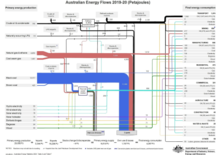
| Year | Oil | Coal | Natural Gas | Renewables | Total |
|---|---|---|---|---|---|
| 2009-10 | 2,058 (34.6%) | 2,229 (37.5%) | 1,372 (23.1%) | 286 (4.8%) | 5,945 |
| 2010-11 | 2,195 (36.0%) | 2,129 (34.9%) | 1,516 (24.8%) | 260 (4.3%) | 6,100 |
| 2011-12 | 2,411 (38.9%) | 2,118 (34.2%) | 1,399 (22.6%) | 265 (4.3%) | 6,194 |
| 2012-13 | 2,221 (37.7%) | 1,946 (33.1%) | 1,386 (23.6%) | 330 (5.6%) | 5,884 |
| 2013-14 | 2,237.8 (38.4%) | 1,845.6 (31.7%) | 1,401.9 (24.0%) | 345.7 (5.9%) | 5,831.1 |
| 2014-15 | 2,237.4 (37.8%) | 1,907.8 (32.2%) | 1,431.0 (24.2%) | 343.3 (5.8%) | 5,919.6 |
| 2015-16 | 2,243.3 (37.0%) | 1,956.1 (32.2%) | 1,504.9 (24.8%) | 361.6 (6.0%) | 6,065.9 |
| 2016-17 | 2,315.4 (37.7%) | 1,936.9 (31.5%) | 1,515.0 (24.7%) | 378.7 (6.2%) | 6,145.8 |
| 2017-18 | 2,387.8 (38.7%) | 1,847.2 (29.9%) | 1,554.6 (25.2%) | 382.1 (6.2%) | 6,171.7 |
| 2018-19 | 2,402.1 (38.8%) | 1,801.6 (29.1%) | 1,592.7 (25.7%) | 399.6 (6.4%) | 6,196.0 |
| 2019-20 | 2,241.2 (37.3%) | 1,706.6 (28.4%) | 1,647.2 (27.4%) | 418.8 (7.0%) | 6,013.8 |
| 2020-21 | 2,097.9 (36.2%) | 1,661.0 (28.7%) | 1,568.2 (27.1%) | 462.4 (8.0%) | 5,789.6 |
| 2021-22 | 2,103.4 (36.5%) | 1,586.8 (27.5%) | 1,559.3 (27.1%) | 512.5 (8.9%) | 5,762.1 |
In 2009, Australia had the highest per capita CO2 emissions in the world. At that time, Maplecroft's CO2 Energy Emissions Index (CEEI) showed that Australia releases 20.58 tons of CO2 per person per year, more than any other country. However, emissions have since been reduced. From 1990 to 2017, emissions per capita fell by one-third, with most of that drop occurring in the more recent years. Additionally, the emissions intensity of the economy fell by 58.4 percent during the same time period. These are the lowest values in 27 years.
The energy sector in Australia increased its carbon dioxide emissions by 8.2% from 2004 to 2010 on average.
Fuels
Coal
Further information: Coal in AustraliaIn 2003, coal-fired plants produced 58.4% of the total capacity, followed by hydropower (19.1%, of which 17% is pumped storage), natural gas (13.5%), liquid/gas fossil fuel-switching plants (5.4%), oil products (2.9%), wind power (0.4%), biomass (0.2%) and solar (0.1%).
The total generating capacity from all sources in 2008-9 was approximately 51 gigawatts (68,000,000 hp) with average capacity utilisation of 52%. Coal-fired plants constituted a majority of generating capacity which in 2008-9 was 29.4 gigawatts (39,400,000 hp). In 2008–9, a total of 143.2 terawatt-hours (516 PJ) of electricity was produced from black coal and 56.9 terawatt-hours (205 PJ) from brown coal. Depending on the cost of coal at the power station, the long-run marginal cost of coal-based electricity at power stations in eastern Australia is between 7 and 8 cents per kWh, which is around $79 per MWh. In 2009, Australia was the fourth-highest coal producer in the world, producing 335 megatonnes (Mt) of anthracite (black coal) and 64 Mt of lignite (brown coal). Australia was the biggest anthracite exporter, with 31% of global exports (262 Mt out of 836 Mt total). Lignite is not exported. 78% of its 2009 anthracite production was exported (262 Mt out of 335 Mt total). In this respect, Australia is an exception to most anthracite exporters. Australia's global anthracite export share was 14% of all production (836 Mt out of 5,990 Mt total).
In 2021, Australia was the world's fifth-largest hard coal producer, following China, India, the United States, and Indonesia. Coal remained important to Australia's energy sector, representing 64% of domestic energy production, 32% of the Total Energy Supply (TES), and 53% of electricity generation. Moreover, Australia had the second-highest usage of coal in energy production and electricity generation among International Energy Agency (IEA) countries. Between 2010 and 2020, the share of coal in energy production dropped from 76% to 65%, in TES from 40% to 30%, and in electricity generation from 71% to 55%.
In 2020, Australia operated 91 hard coal and three lignite mines, with over 200 coal deposits. Most hard coal mines were in Queensland (67%) and New South Wales (30%), while lignite mines were mainly in Victoria's Gippsland Basin, notably the Latrobe Valley.
Natural gas

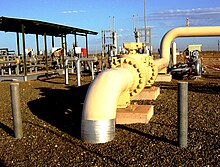
Australia's natural-gas reserves are an estimated 3,921 billion cubic metres (bcm), of which 20% are considered commercially proven (783 bcm). The gas basins with the largest recoverable reserves are the Carnarvon and Browse basins in Western Australia; the Bonaparte Basin in the Northern Territory; the Gippsland and Otway basins in Victoria and the Cooper-Eromanga basin in South Australia and Queensland. In 2014–2015 Australia produced 66 bcm of natural gas, of which approximately 80% was produced in Western Australia and Queensland regions. Australia also produces LNG; LNG exports in 2004 were 7.9 Mt (10.7 bcm), 6% of world LNG trade. Australia also has large deposits of coal seam methane (CSM), most of which are located in the anthracite deposits of Queensland and New South Wales.
On 19 August 2009, Chinese petroleum company PetroChina signed a A$50 billion deal with American multinational petroleum company ExxonMobil to purchase liquefied natural gas from the Gorgon field in Western Australia, the largest contract signed to date between China and Australia. It ensures China a steady supply of LPG fuel for 20 years, forming China's largest supply of relatively clean energy. The agreement was reached despite relations between Australia and China being at their lowest point in years after the Rio Tinto espionage case and the granting of an Australian visa to Rebiya Kadeer.
In 2021, natural gas was a significant component of Australia's energy sector, making up 29% of its energy production, 28% of the Total Energy Supply (TES), 19% of electricity generation, and 17% of Total Final Consumption (TFC). Sector-wise, natural gas usage was highest in electricity and heat generation at 33.9%, followed by the industrial sector at 23.3%. Residential buildings accounted for 10.8% of natural gas consumption, while service sector buildings and the transport sector had smaller shares at 2.9% and 1.3%, respectively.
Oil
Australia's oil production peaked in 2000, after gradually increasing since 1980. Net oil imports rose from 7% of total consumption in 2000 to 39% in 2006. Decreasing domestic oil production is the result of the decline of oil-producing basins and few new fields going online.
In 2021, oil comprises 52% of the Total Final Consumption (TFC) and 32% of the Total Energy Supply (TES). It contributes to 4% of domestic energy production and 1.8% of electricity generation. Oil consumption in 2020 was 892.3 thousand barrels per day (kb/d), with domestic transport consuming 65.4% of this amount. Industry, including non-energy consumption, accounted for 22.4%, international bunkering for 9.1%, buildings for 2.4%, and electricity and heat generation for 0.4%.
Oil shale
Main article: Oil shale in AustraliaAustralia's oil shale resources are estimated at 58 billion barrels, or 4,531 million tonnes of shale oil. The deposits are located in the eastern and southern states, with the greatest feasibility in the eastern Queensland deposits. Between 1862 and 1952, Australia mined four million tonnes of oil shale. The mining stopped when government support ceased. Since the 1970s, oil companies have been exploring possible reserves. From 2000 to 2004, the Stuart Oil Shale Project near Gladstone, Queensland produced over 1.5 million barrels of oil. The facility, in operable condition, is on care and maintenance and its operator (Queensland Energy Resources) is conducting research and design studies for the next phase of its oil-shale operations. A campaign by environmentalists opposed to the exploitation of oil-shale reserves may also have been a factor in its closure.
As of 2021, Australia no longer engages in the commercial production of oil shale.
Biomass
Biomass power plants use crops and other vegetative by-products to produce power similar to the way coal-fired power plants work. Another product of biomass is extracting ethanol from sugar mill by-products. The GGAP subsidies for biomass include ethanol extraction with funds of $7.4M and petrol/ethanol fuel with funds of $8.8 million. The total $16.2M subsidy is considered a renewable energy source subsidy.
Biodiesel
Biodiesel is an alternative to fossil fuel diesel that can be used in cars and other internal combustion engine vehicles. It is produced from vegetable or animal fats and is the only other type of fuel that can run in current unmodified vehicle engines.
Subsidies given to ethanol oils totaled $15 million in 2003–2004, $44 million in 2004–2005, $76 million in 2005–2006 and $99 million in 2006–2007. The cost for establishing these subsidies were $1 million in 2005–2006 and $41 million in 2006–2007.
However, with the introduction of the Fuel Tax Bill, grants and subsidies for using biodiesel have been cut leaving the public to continue using diesel instead. The grants were cut by up to 50% by 2010–2014. Previously the grants given to users of ethanol-based biofuels were $0.38 per litre, which were reduced to $0.19 in 2010–2014.
Geothermal
Main article: Geothermal power in AustraliaThere are vast deep-seated granite systems, mainly in central Australia, that have high temperatures at depth and these are being drilled by 19 companies across Australia in 141 areas. They are spending A$654 million on exploration programs. South Australia has been described as "Australia's hot rock haven" and this emissions-free and renewable energy form could provide an estimated 6.8% of Australia's baseload power needs by 2030. According to an estimate by the Centre for International Economics, Australia has enough geothermal energy to contribute electricity for 450 years.
Uranium
Main article: Uranium mining in AustraliaAustralia has many Uranium deposits. However, Australia does not have any nuclear power plants.
Electricity
Main article: Electricity sector in AustraliaSince 2005, wind power and rooftop solar have led to an increasing share of renewable energy in total electricity generation. Due to its large size and the location of its population, Australia lacks a single grid.
| Year | Black Coal | Natural Gas | Brown Coal | Oil | Other | Fossil Fuels |
Solar | Wind | Hydro | Bio Energy | Renew- ables |
|---|---|---|---|---|---|---|---|---|---|---|---|
| 2009-10 | 51.5% (124,478) | 15.0% (36,223) | 23.2% (55,968) | 1.1% (2,691) | 1.0% (2,496) | 91.8% | 0.1% (278) | 2.0% (4,798) | 5.2% (12,522) | 0.9% (2,113) | 8.2% |
| 2010-11 | 46.3% (116,949) | 19.4% (48,996) | 21.9% (55,298) | 1.2% (3,094) | 1.1% (2,716) | 89.9% | 0.3% (850) | 2.3% (5,807) | 6.7% (16,807) | 0.8% (2,102) | 10.1% |
| 2011-12 | 47.4% (120,302) | 19.3% (48,892) | 21.7% (55,060) | 1.2% (3,070) | 1.0% (2,500) | 90.6% | 0.6% (1,489) | 2.4% (6,113) | 5.5% (14,083) | 0.9% (2,343) | 9.4% |
| 2012-13 | 44.8% (111,491) | 20.5% (51,053) | 19.1% (47,555) | 1.8% (4,464) | 0.8% (1,945) | 86.9% | 1.5% (3,817) | 2.9% (7,328) | 7.3% (18,270) | 1.3% (3,151) | 13.1% |
| 2013-14 | 42.6% (105,772.4) | 21.9% (54,393.9) | 18.6% (46,076.2) | 2.0% (5,012.4) | - | 85.1% | 2.0% (4,857.5) | 4.1% (10,252.0) | 7.4% (18,421.0) | 1.4% (3,511.3) | 14.9% |
| 2014-15 | 42.7% (107,639) | 20.8% (52,463) | 20.2% (50,970) | 2.7% (6,799) | - | 86.3% | 2.4% (5,968) | 4.5% (11,467) | 5.3% (13,445) | 1.4% (3,608) | 13.7% |
| 2015-16 | 44.4% (114,295) | 19.6% (50,536) | 19.0% (48,796) | 2.2% (5,656) | - | 85.2% | 2.7% (6,838) | 4.7% (12,199) | 6.0% (15,318) | 1.5% (3,790) | 14.8% |
| 2016-17 | 45.8% (118,272) | 19.6% (50,460) | 16.9% (43,558) | 1.9% (4,904) | - | 84.3% | 3.1% (8,072) | 4.9% (12,597) | 6.3% (16,285) | 1.4% (3,501) | 15.7% |
| 2017-18 | 46.6% (121,702) | 20.6% (53,882) | 13.8% (36,008) | 1.9% (4,904) | - | 82.9% | 3.8% (9,930) | 5.8% (15,174) | 6.1% (16,021) | 1.3% (3,518) | 17.1% |
| 2018-19 | 45.4% (119,845) | 20.0% (52,775) | 13.1% (34,460) | 1.9% (4,923) | - | 80.3% | 5.6% (14,849) | 6.7% (17,712) | 6.0% (15,967) | 1.3% (3,496) | 19.7% |
| 2019-20 | 42.2% (111,873) | 20.8% (55,216) | 12.7% (33,649) | 1.7% (4,509) | - | 77.4% | 7.9% (21,033) | 7.7% (20,396) | 5.7% (15,150) | 1.3% (3,352) | 22.6% |
| 2020-21 | 40.0% (106,251) | 18.7% (49,783) | 12.8% (34,060) | 1.8% (4,662) | - | 73.3% | 10.4% (27,717) | 9.2% (24,535) | 5.7% (15,200) | 1.3% (3,346) | 26.7% |
| 2021-22 | 37.2% (101,076.2) | 18.1% (49,280.2) | 12.0% (32,515.6) | 1.7% (4,664.0) | - | 69.1% | 12.8% (34,686.7) | 10.7% (29,107.8) | 6.3% (17,010.9) | 1.2% (3,190.3) | 30.9% |
| 2022-23 | 35.0% (96,173.9) | 17.8% (48,865.2) | 11.5% (31,459.1) | 1.8% (4,864.4) | - | 66.1% | 15.3% (41,968.5) | 11.4% (31,384.9) | 6.1% (16,666.1) | 1.1% (3,092.8) | 33.9% |
Australian Electricity Generation by Type FY 2022-2023
Black Coal (35.0%) Natural Gas (17.8%) Brown Coal (11.5%) Oil (1.8%) Solar (15.3%) Wind (11.4%) Hydro (6.1%) Bio Energy (1.1%)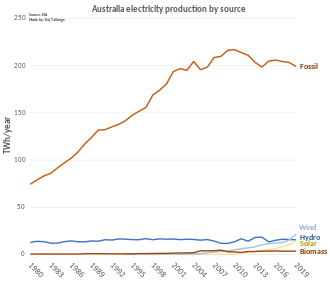
Electricity supply

As of 2011, electricity producers in Australia were not building gas-fired power stations, while the four major banks were unwilling to make loans for coal-fired power stations, according to EnergyAustralia (formerly TRUenergy). In 2014, an oversupply of generation was expected to persist until 2024. However, a report published in 2017 by the Australian Energy Market Operator projected that energy supply in 2018 and 2019 is expected to meet demands, with a risk of supply falling short at peak demand times.
From 2003 to 2013 real electric prices for households increased by an average of 72%. Much of this increase in price has been attributed to over-investment in increasing distribution networks and capacity. Further price increases are predicted to be moderate over the next few years (2017 on) due to changes in the regulation of transmission and distribution networks as well as increased competition in electricity wholesale markets as supply and demand merge.
In 2021, Australia generated a total of 265 Terawatt-hours (TWh) of electricity. The breakdown of the electricity generation mix was as follows: coal at 52.9%, natural gas at 18.8%, solar at 10.5%, wind at 9.3%, hydro at 5.6%, oil at 1.8%, and bioenergy and waste at 1.3%. Electricity consumption for the year was 239 TWh, with the industry sector consuming 43%, residential buildings and service sector buildings each contributing 27% to the total consumption, and the transport sector accounting for 3%.
Renewable energy
Main article: Renewable energy in Australia Further information: Wind power in Australia, Feed-in tariffs in Australia, Solar power in Australia, Solar thermal energy in Australia, and Solar hot water in Australia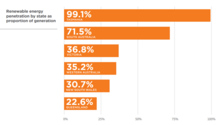
Renewable energy has potential in Australia, and the Climate Change Authority is reviewing the 20-percent Renewable Energy Target (RET). The production of 50 megawatts of wind power (power for nearly 21,000 homes annually) creates about 50 construction jobs and five staff positions. In recent years, wind and solar power have been the fastest growing source of energy in Australia. Geothermal energy is also growing, but at the present time, it only accounts for a small portion of energy in Australia.
Energy efficiency
Lower energy use could save A$25 billion, or A$840 per electricity customer, according to EnergyAustralia.
Climate change
Main article: Climate change in Australia
Australian total emissions in 2007 were 396 million tonnes of CO2. That year, the country was among the top polluter nations of the world per capita. Australian per-capita emissions of carbon dioxide in 2007 were 18.8 tons of CO2, compared to the EU average of 7.9 tons. The change in emissions from 1990 to 2007 was +52.5 percent, compared to the EU's -3.3 percent. The per-capita carbon footprint in Australia was rated 12th in the world by PNAS in 2011.
Due to climate change, Australia is expected to experience harsher extreme weather events, mainly bush-fires and floods during summer. Rising sea levels are of particular concern for Australia, because most of the population lives on the coast (around 85%).
Employment

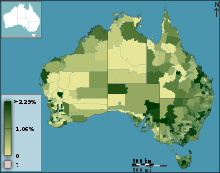
When analysing employment data, the Australian Bureau of Statistics classifies the electricity and gas supply industry as part of the Electricity, Gas, Water and Waste Services Division. That division is the smallest industry in Australia in terms of employment.
In November 2017, the number of people employed in electricity supply, which includes electricity generation, transmission and distribution, was 64,200 (47,700 males, 16,600 females). The number of people employed in gas supply was 11,200 (9,000 males, 2,200 females). The total number of persons employed in electricity and gas supply industries was 75,400. This represents about 0.67 percent of all employed persons in Australia.
In 2016, the major occupations in this division were truck drivers (9,900), electricians (7,700), electrical distribution trades workers (5,400), and electrical engineers (4,400).
Employment in renewable energy activities
In 2015–16, annual direct full-time equivalent employment in renewable energy in Australia was estimated at 11,150. Employment in renewables peaked in 2011–12, probably due to the employment of construction workers to build renewable energy facilities. However, it decreased by 36 percent in 2014–15, and by a further 16 percent in 2015–16. The decline is attributed to a decrease in the number of roof-top solar photovoltaic systems being installed on houses. Once construction of renewable energy facilities is completed, and only ongoing maintenance is required, employment falls quite significantly.
For most Australian states and territories the major contributor to employment in renewable energy is solar power. Employment in roof-top solar photovoltaic systems, including solar hot water systems, comprised half of all employment in renewable energy in 2015–16. Employment in large scale solar and wind power is driven primarily by installation activity, rather than ongoing operation and maintenance.
In Western Australia, 93 percent of all jobs in renewable energy are in solar power. The proportion of employment in biomass is significantly greater in Queensland (42 percent), where the sugar industry makes great use of sugar cane to generate electricity for sugar milling and to feed into the grid. Most jobs in Tasmania's renewable energy industry are in hydropower (87 percent).
Jobs in the renewable energy industry are forecast to grow substantially by 2030, driven by growth in electricity demand and new renewable energy capacity. Conversely, jobs associated with coal-fired power stations are forecast to decline as those plants age and close. Such job losses would disproportionately affect some regional areas, such as the Latrobe Valley in Victoria, Newcastle and the Hunter Valley in New South Wales, Gladstone and Rockhampton in Queensland, and Collie in Western Australia. However, it is expected that the number of jobs created in renewable energy will far exceed the number of jobs lost in coal-based generation.
Energy policy of Australia
Main article: Energy policy of Australia
See also
- Fossil-fuel phase-out
- List of coal-fired power stations in Australia
- List of natural gas fired power stations in Australia
- Australian Renewable Energy Agency
Notes
References
- "Australia 2023 – Analysis". IEA. 19 April 2023. Retrieved 11 March 2024.
- "Australia Country Analysis Brief". 2002. Archived from the original on 2 April 2016. Retrieved 19 October 2016.
- "New Zealand says goodbye to coal power". antinuclear.net. 7 August 2015. Retrieved 26 November 2015.
- "China starts moving away from coal based energy". Spokesman.com. 13 September 2013. Retrieved 26 November 2015.
- Clean Energy Council Australia. "Clean Energy Australia Report 2024" (PDF). Clean Energy Australia. Retrieved 29 December 2024.
- ^ "Australian Energy Statistics | energy.gov.au". www.energy.gov.au. Retrieved 8 August 2020.
- "The World's Biggest Polluters". The New Ecologist. 15 October 2009. Retrieved 19 April 2018.
- Energy, Department of the Environment and (26 July 2017). "Department of the Environment and Energy". Department of the Environment and Energy. Retrieved 7 September 2017.
- OECD/IEA, p. 96
- IEA Key energy statistics 2010 Archived 11 October 2010 at the Wayback Machine Pages: 15
- IEA Key energy statistics 2010 Archived 11 October 2010 at the Wayback Machine Pages:15
- ^ "Australia 2023 - Energy Policy Review" (PDF). International Energy Agency. 2023.
- "Australian Energy Statistics".
- ^ OECD/IEA, pp. 131–137
- Stephen McDonell, 19 August 2009, Record gas deal between China and Australia – AM – Australian Broadcasting Corporation
- Babs McHugh, 19 August 2009, Massive sale from Gorgon Gas Project – Australian Broadcasting Corporation
- David McLennan, 20 August 2009, Australia to be 'global supplier of clean energy' Archived 18 September 2009 at the Wayback Machine – The Canberra Times
- Peter Ryan, 19 August 2009, Deal means 2.2 million tonnes exported per year – AM – Australian Broadcasting Corporation
- ^ Australia: Energy profile Archived 1 October 2011 at the Wayback Machine 26 June 2007, Energy Publisher accessdate 3 July 2011
- Shale oil. AIMR Report 2006 Geoscience Australia, accessdate=30 May 2007 archivedate 13 February 2007
- Climate-changing shale oil industry stopped Archived 28 November 2007 at the Wayback Machine Greenpeace Australia Pacific, 3 March 2005, accessdate 28 June 2007
- "Energy Grants (Cleaner Fuels) Scheme Bill 2003". Archived from the original on 11 September 2006.
{{cite journal}}: Cite journal requires|journal=(help) - Biodiesel – fuel tax credits and fuel grant entitlements Archived 30 September 2007 at the Wayback Machine. Australian Taxation Office.
- "Biodiesel industry fearful of future after subsidy cuts". Australian Broadcasting Corporation.
{{cite journal}}: Cite journal requires|journal=(help) - "Alternative Fuels and Energy – Biodiesel Newsletter #6" (PDF). Archived from the original (PDF) on 29 August 2007.
{{cite journal}}: Cite journal requires|journal=(help) - "Scientists get hot rocks off over green nuclear power". The Sydney Morning Herald. 12 April 2007. Archived from the original on 24 September 2015.
- "Uranium Supplies: Supply of Uranium - World Nuclear Association".
- "State of the energy market, 2020 | Australian Energy Regulator". www.aer.gov.au. Retrieved 11 July 2017. Comparable to previous years statistical calculation criteria, 2018, 2017, 2015, 2014, 2013, 2012, 2011, and 2010
- http://www.genifoundation.org.au/images/Energy_Grid_Aust_2009_April_m.jpg
- (22 May 2011).Carbon tax is delaying investment: McIndoe. Inside Business. Australian Broadcasting Corporation. Retrieved on 12 March 2012.
- Royce Millar & Adam Morton (21 May 2011). Big banks 'no' to coal plant. The Age. Fairfax Media. Retrieved on 12 March 2012.
- Mark, David (8 August 2014). "Australia faces unprecedented oversupply of energy, no new energy generation needed for 10 years: report". ABC. Retrieved 7 September 2017.
- "Energy Supply Outlook" (PDF). AEMO. Retrieved 7 September 2017.
- Swoboda, Kai. "Energy prices—the story behind rising costs". Parliament of Australia. Retrieved 12 September 2017.
- "Clean Energy Australia Report 2023". 17 April 2023.
- scheme (2012).Energy Council
- "Wind Farm Investment, Employment and Carbon Abatement in Australia" (PDF). Archived from the original (PDF) on 19 April 2013. Retrieved 10 October 2012.
- "Australia tipped to add 70,000 home batteries in 2019, lead global demand". 11 February 2019.
- "Australia's largest solar farm opens amid renewable target debate". The Guardian. 10 October 2012.
The Greenough River Solar project in Western Australia is expected to have enough capacity to power 3,000 homes.
- Energy in Sweden 2010 Archived 16 October 2013 at the Wayback Machine, Table 1: Emissions of carbon dioxide in total, per capita and per GDP in EU and OECD countries, 2007
- Which nations are really responsible for climate change - interactive map The Guardian 8 December 2011 (All goods and services consumed, source: Peters et al PNAS, 2011)
- Head, Lesley; Adams, Michael; McGregor, Helen V.; Toole, Stephanie (1 March 2014). "Climate change and Australia". Wiley Interdisciplinary Reviews: Climate Change. 5 (2): 175–197. Bibcode:2014WIRCC...5..175H. doi:10.1002/wcc.255. ISSN 1757-7799. S2CID 131481369.
- Energy, Department of the Environment and (2 June 2014). "Department of the Environment and Energy". Department of the Environment and Energy. Retrieved 7 September 2017.
- Australian Bureau of Statistics; Statistics New Zealand (2006). Australian and New Zealand Standard Industrial Classification 2006 (ANZSIC) (PDF) (Report). Australian Bureau of Statistics. p. 200.
- "Electricity, Gas, Water, Waste Services". Job Outlook. Retrieved 22 December 2017.
- ^ Australian Bureau of Statistics (2017). 6291.0.55.003 - Labour Force, Australia, Detailed, Quarterly, Nov 2017, Table 06. Employed persons by Industry sub-division of main job (ANZSIC) and Sex (Report). Australian Bureau of Statistics.
- Department of Employment, Australian Government (2016). 4. Main Employing Occupations (Report). Department of Employment, Australian Government.
- ^ Australian Bureau of Statistics (2017). 4631.0 - Employment in Renewable Energy Activities, Australia, 2015-16 (Report). Australian Bureau of Statistics.
- ^ Climate Council of Australia (2016). Renewable Energy Jobs: Future Growth in Australia (PDF). Climate Council of Australia. ISBN 978-0-9945973-3-5.
| Energy policy of Australia | |
| Fossil fuel industry | |
| Renewable energy industry | |
| Policies and targets | |
| Nuclear power | |
| Agencies |
|
| Research | |
| Energy in Australia by state | |
| Australia articles | |||||
|---|---|---|---|---|---|
| History |
| ||||
| Geography |
| ||||
| Politics |
| ||||
| Economy | |||||
| Society |
| ||||
| Economy of Australia | |
|---|---|
| History | |
| Currency | |
| State economies | |
| Industries | |
| Taxation | |
| Banking and Finance | |
| Regulatory agencies | |
| Energy | |
| Economic conditions | |
| Unions | |
| Trade agreements | |